Speaker Tips for New and Experienced Community Summit NA Speakers

These speaking suggestions are designed to help you prepare for your upcoming Community Summit NA speaking engagement. Drawing from over 20 years of experience in public speaking, I am eager to share what has worked well for me and the valuable lessons I have learned along the way. One crucial step before creating your speech and presentation is to submit a proposal for your session.
The Proposal
This is the process of pitching your session idea to the programming committee. When developing a session proposal, you will need specific details about the session you plan to deliver. Start by addressing the following questions:
- Session Title: What captivating title will you choose for your session?
- Abstract/ Description: Provide a brief summary of the session and outline the key topics that will be addressed.
- Audience: Who is the target audience for this session (e.g., beginners, advanced professionals, specific industry groups)?
- Learning Objectives: What do you want attendees to learn or take away from your session?
- Speaker: Do you want to include any specific details about your background or qualifications that are relevant to the session?
Now that your session has been accepted… what do you do next?
Do Not Procrastinate
Get started on your presentation as soon as you can. The more time you leave yourself to develop your presentation, the better it will be, and you will have more opportunities to practice your presentation skills.
Now that your proposal has been accepted by the Programming Committee, let’s start working on the presentation.
Preparation
Do not start your preparation process on PowerPoint. Begin with a basic flow diagram like a roadmap. Each block in the diagram can represent a key point you want to get across. This approach allows you to visualize the entire presentation and see the flow of your ideas. When designing your presentation, it’s helpful to start with asking a thought-provoking question related to your topic. Then, as you progress through your flow, provide persuasive points supported by facts, and then conclude by illustrating a real-world situation where these points have been effective.
Now that you have a roadmap, you need to design your PowerPoint. The trick to a good PowerPoint presentation is to use the least amount slides that give you the strongest impact. Each slide should convey the main thoughts/ ideas of what you are presenting by using images and catch phrases.
Your audience should get a sense of the direction of your presentation and you should NOT be reading the slides.
Utilize the Presenter Notes. This space, hidden from the screen during your oral presentation, but present in the written format of Power Point, is where you can provide all the details to the audience when they download your slides.
Finally, make sure to leave ample time for questions and discussion. If you have a total of 50 minutes, keep your presentation to 40-45 minutes at the most to allow time for engagement with the audience.
Practice
After you have designed your presentation, remember to practice, practice, and practice some more! Practicing your presentation is crucial for success. Start by practicing at your desk to review your material and timing and make any necessary adjustments. Then, move on to practicing as if you are at the actual conference. I recommend dressing and setting up your computer just as you would for the conference to ensure that your attire and equipment placement work well for you. A standard podium has a desktop that is 26″ wide by 14″ deep. If you like, you can also record yourself to see how you come across to the audience. Finally, consider doing a dry run through if time allows, such as presenting to a small group of people who are familiar with the topic, like at a User Group Meeting. This allows for valuable feedback from individuals who understand the material.
Promotion
You now have this awe-inspiring session to present, so how do you draw people in?
When presenting as part of a larger conference, they will often help you out with some marketing, such as listing you on the syllabus of topic offerings or maybe mentioning you in an article or email trying to energize potential attendees. It is still recommended that you add your own individualized “marketing” hype. Marketing materials can include things like creating:
- An event logo
- PowerPoint templates
- Email tags
- An event webpage
Write a concise but informative 1 or 2-paragraph description that will grab the attention of potential attendees. Social media platforms are the core marketing techniques used today. With LinkedIn and X, be mindful of character limits, #hastags, and @tags to maximize impressions. First impressions are what will drive viewers to your posting. The title and image you choose are crucial for making a strong first impression and driving viewers to your post, as this is the first thing people will see and use to decide whether to investigate further. Email blasts are another promotion technique that is utilized. Keep them concise and eye-catching to stand out in crowded inboxes.
Lastly, begin promoting your session as soon as you are confirmed as a speaker to maximize market impact.
Presenting
The key aspect of being a speaker is delivering a compelling presentation to your audience.
It might sound simple, but even after 25+ years of experience, I still get butterflies just before I go up to give a presentation. Here are a few dos and don’ts to keep in mind when you are standing at the podium.
Do…
- Arrive early and interact with people before your presentation: This will help you relax and remind you that the audience is just like you, and they are there to learn. Use this time to set up your computer and prepare your slides before your scheduled start time.
- Make eye contact and engage with the audience: This will help you feel better and more relaxed.
- Always have a backup plan for technical issues: If you’re presenting active demos, something is bound to go wrong, it’s guaranteed. Prepare by having screenshots of what the working demo should look like.
- Start your presentation by asking a question: This is a great way to engage with the audience right from the beginning.
- Relax, smile, and BE YOURSELF: Remember, you are helping the community by sharing your knowledge. People attend because they are interested in your experience and what you have to say
- Bring business cards: This will allow people to get in touch with you later, as there may not be much time for networking after your session.
- Remember to ask for feedback at the end of your presentation: You should ask for both positive feedback and suggestions for improvement. The last slide of your presentation should contain a link to a survey for feedback or contact information for providing feedback.
Don’t…
- Start early or late: Start at the designated time. Starting early may upset those who arrive promptly, while starting late may cut into discussion time
- Read from a script: You know your material, you wrote it; just relax and be yourself.
- Go over the time allotted: This is a critical NO-NO. People have other sessions to attend after yours and if you have not finished – well they feel like the missed the best part of the next movie. Or, it can also cut into the valuable active discussion time designated for the end of the session if they choose to leave.
- Hide behind the podium or desk: They still see you, so it didn’t actually work.
- Talk too fast: This is nerves. When you talk too fast, you do not get your point across, and you miss communicating the passion you have of the topic to your audience.
- Head down the rabbit hole: This is my particular weakness, as being very passionate about my topics often gets me into the weeds. While it’s great to be passionate about your topic, delving too deeply can cause you to lose control of your presentation and the audience’s interest.
I hope these tips will help you feel more prepared for your next speaking opportunity.


